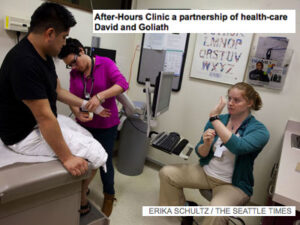Last time you walked through the supermarket, you may have noticed that the pharmacy expanded with some sort of clinic. There are more doc-in-the-boxes in your neighborhoods too as urgent care facilities have expanded into neighborhoods across the country.
It doesn’t end there, though, as standalone emergency rooms, multi-specialty facilities and more are increasingly getting developed within popular areas to reach patients in their communities. This is healthcare going retail.
The urgent care market reached $15 billion recently, with the number of urgent care facilities rising to 10,000 in 2017.
Not many industries are as hotly debated like healthcare, or as transformational while looking at an uncertain future.
For years, since about the time of the passage of the Affordable Care Act, health networks and hospitals have been working to transition from sick-care to well-care, the idea of keeping people healthy before they get sick and are in need of costly acute care.
This has made healthcare providers expand into things like urgent care facilities, ownership of primary care physician practices and specialty practices.
And with this expansion, health providers have had to develop and lease more spaces while also bringing many spaces onto their books through acquisitions and mergers.
Many of these spaces are retail in nature, with flashy neon signs, late hours like a retail chain and more as a way to get customers, or patients, into the door when it’s convenient for the patient.
Patients also have more choice in where they get treatment too, as they become the consumers. Having more choice in location of care has helped technology innovations grow too while also creating more competition between providers.
CVS is acquiring the health insurer Aetna for $69 billion, and they hope to reduce rising healthcare costs by treating patients within CVS’s walk-in clinics. Walmart and Humana are reportedly in talks to have a closer relationship too.
The plan behind making healthcare more retail is to give patients better access. Hospitals are going into the communities where people live in order to treat them before patients get too sick and have to go to a hospital.
This whole transition has also been helping traditional retail as folks go on and shop at other nearby retail locations while they wait for a friend or family member to see the doctor.
Things to think about retail health care
As healthcare becomes more like retail, there’s a few things to consider for your local communities. It’s important to find out where this trend is happening in your coverage area, because aiming to reduce healthcare costs through this method while ignoring some communities may be counter-intuitive.
There’s also the question as to how this is impacting the retail real estate market within your coverage area. Has the rise of e-commerce hit your retail market? Might more healthcare leases alleviate that crunch?
You can also look into how zoning laws may be facilitating this adoption of healthcare in retail spaces, or keeping it from happening.
And then there are malls. Malls have been changing and fading away in some places. Arizona has a defunct mall that’s being redeveloped into a healthcare and education campus that will be designed for healthcare learning centers while also having entertainment options.
The real estate side of healthcare is a very interesting space to watch, so be sure to keep an eye on how providers in your area are using space to treat patients as the industry continues through its changes.











